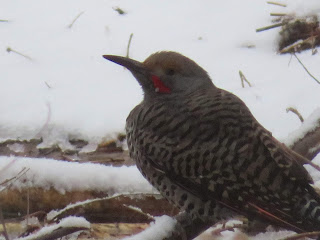More than a few people have been worried about how animals cope with unexpected cold spells. Of course, we only worry about some animals. This cold snap is perfect for reducing the spread of certain wood boring beetles, even as it will kill large numbers of developing buds from many types of trees.
Unprecedented snowy weather in the area suggests we should have a good snow pack for the summer growing season. But this could also be a bad thing if that water combines with summer monsoons to cause flood conditions. Areas of the state like San Acacia (beautiful place, but if you go, be prepared; it's rough) still suffer from farmland flooding along the Rio Grande. The city of Albuquerque is between two dams; the Cochiti and Elephant Butte. These help control water flows, but also causes erosion problems in Corrales.
Many animals rely on wetlands and flooding. Those dams allowed development to occur along the river since the 1930's, but also caused the extinction of native species of large fish such as sturgeon and gar that used to exist in the Rio Grande. Other animals, such as the silvery minnow only survive by large infusions of money and manpower.

The wetlands that are left do still support many species. This heron is in his usual resting spot. He seems to be a little late starting his fishing routine today, but given the lack of dogs and people, he is probably giving up prime fishing time.
The doves moved into the bosque in large numbers recently, probably to take advantage of the large numbers of bird feeders in the area and to nest. This one was busy preening under the shelter of a large tree branch. Preening is a big part of all bird's daily activities. Most birds have a sizable parasite population, both on the inside and outside. Bird malaria is one of the reasons that the Biopark's penguins can't be outside in the summer, they have no immunity.
The rabbits were out early this morning, trying to find a place out of the snow while close to green grass shoots. Many coneys chose to sit under a vehicle and nibble grass lawns that until recently were being irrigated and growing quickly on fertilizer and weed killer.
The birds in the area continue to come and go across the state in response to the weather and ecosystems. This trailcam is not really designed for small birds, but shows a yellow finch, not a regular visitor to the bird bath. Eventually we should see flashes of scarlet in the trees as Summer tanagers stop by. Right now there are occasional glimpses of the dark blues from bluebirds.
Everything comes with a downside, and these bird baths can also spread poorly understood diseases, such as West Nile Virus (which we know) and Usutu (which we don't). They need to be emptied and monitored regularly. I put a bullfrog tadpole in mine during the summer, works a treat at removing insect larvae.






No comments:
Post a Comment